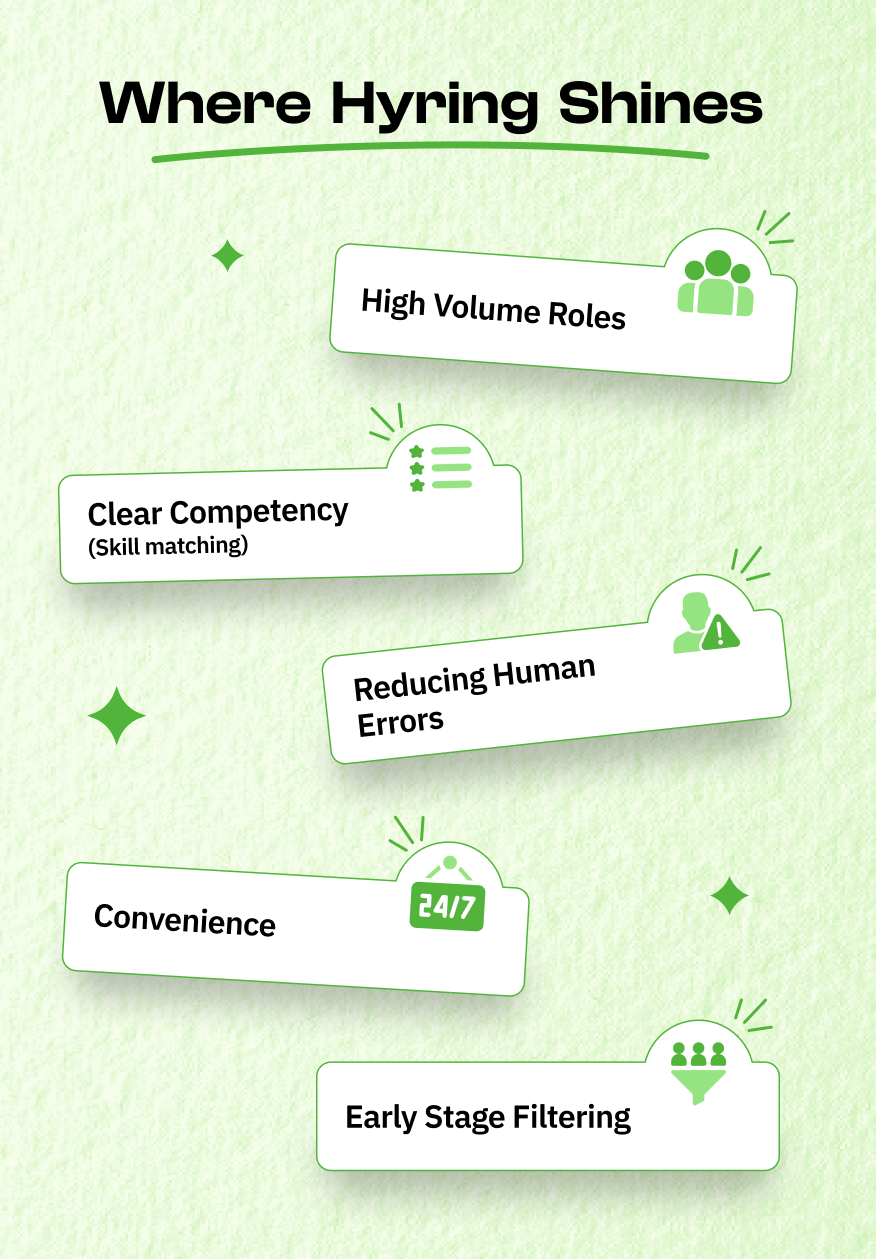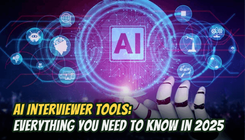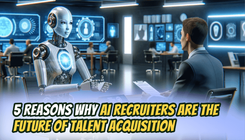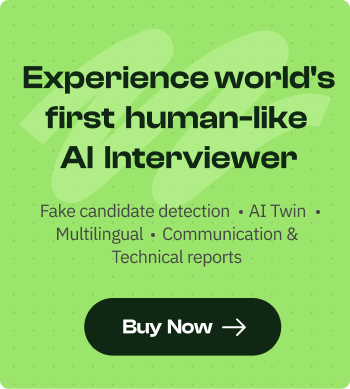AI Recruiters vs. Human Recruiters: 101
Table of Contents
- The Rise of AI in Hiring
- What Recruiters Actually Do
- What Recruiters Do That AI Still Can’t
- It's Not Just “AI vs Human” but How They Work
- Where AI Recruiters like Hyring Shine
- Where Human Recruiters Beat AI Recruiters (By A Lot)
- What Candidates Actually Prefer (The Human Reactions)
- Real-World Example: A Case Study
- The Future: A Hybrid Model
- Fact vs Fiction
- Final Thoughts
Imagine you’re a candidate having to log on to an interview link, the clock starts ticking, a series of questions appear in quick succession, and you start speaking into your webcam. There’s no beaming person sitting across the table, no friendly chit chat or conversations in real time about your last role or your gross salary.
You wonder - Is someone watching me live from beyond the veil, or is an algorithm analyzing what I say and how I say it, which is in no way less creepy if one comes to think of it.
In today’s hiring market, the line between automated, artificially intelligent interviewers and real-people recruiters is becoming blurred. Large employers and staffing platforms increasingly use what we’ll call AI recruiters to handle early-stage screening. Yet, the human recruiter remains central for culture, interpretation, and natural intuition, which is called clear sentience. So what actually differentiates the two?
And what does it mean for candidates and companies alike? We will delve into the same while meandering our way through this blog.
The Rise of AI in Hiring
There are compelling reasons companies use AI systems for interviewing. Firstly, volume. When you receive thousands of applications for a role, it’s simply impractical for human recruiters to personally screen everyone. Moreover, I’d like to say it is frankly tiring too, and even cumbersome physiologically and psychologically.
Secondly, speed. Hiring decisions need to be faster than ever in competitive talent markets, or else the ‘early bird gets the worm’ literally becomes a reality. Thirdly, consistency and bias reduction. A well-designed screening engine promises to treat all candidates the same way, in an ideal world. Remote/hybrid work norms have further accelerated this shift, and the 2020s even more so, after the pandemic.
In fact, recruitment-tech firms now build video, audio, and text-based “interview bots” or screening modules that are used in place of a first-round human conversation. The debate we’re having now is not if AI interviewing will grow–it will–but how it will change the dynamic of hiring, and whether it eventually lives up to its promise in fairness, accuracy, and the experience offered to candidates throughout the entire process.
What AI Recruiters Actually Do
Let’s break down what these automated systems do in practice.
Initial Screening
Often, the AI interview module presents a series of pre-recorded questions (one-way video or audio) that the candidate responds to. There is no live interaction, no spontaneous follow-up. Because the system needs to handle multiple candidates, interviews are time-boxed, responses captured, and then analysed asynchronously and in parallel. At Hyring, we have multiple services and modes of interviews for the same.
Evaluation Mechanics
Behind the scenes, the system may apply several different techniques:
- Analyzing speech patterns (pace, clarity, hesitations, slurs, quivers)
- Matching candidate responses against keywords, key metrics, or competencies (for example: “Tell me about a time you led a team or took a tough decision that you were proud of” → look for leadership, decision-making, and candidate confidence and clarity)
- Applying scoring rules that are configured for the specific role (For example, five key competencies, each weighted accordingly–like creativity and competency in design for a graphics designer)
- Possibly analyzing video cues (though this is now controversial and difficult to gauge, considering different candidates have different ways of carrying themselves) or audiovisual emotion/intonation.
Strengths
- Consistency: All candidates answer the same questions under the standardised conditions, which are less subject to individual recruiter mood, fatigue, or bias (assuming the engine is well-designed).
- Scalability: The AI recruiter can run hundreds or thousands of interviews concurrently.
- Availability: We don’t have to arrange live interviewers, coordinate time zones, or cross-schedule calendars.
But it’s vital to understand what AI isn’t: it’s not an intuitive judge of character in the way a human is. It isn’t “present” and doesn’t “sit across the table,” read micro-interactions in context, or adjust dynamically unless explicitly built to do so.
Even then, it is subject to errors due to the lack of nuances and inputs that humans normally read through various means. At its core, it’s still pattern-matching or robotic in its approach. As much as we would like to humanize its approach, there's only so much we can do due to present limitations.
Also Read About: 12 Reasons Why AI Interviewers Are Winning Over Recruiters in 2026
What Human Recruiters Do That AI Still Can’t
Here’s where the human advantage kicks in—areas where humans still outperform automated systems.
Contextual Reading
Humans pick up on nuance and contexts that AI recruiters skip most of the time: a candidate’s nervousness, an oddly phrased answer that hints at a strong underlying story, cultural references, humour, awkward pauses that actually signal authenticity. A recruiter can say: “I see you stumbled a little there, but tell me what you were thinking” — nudge the candidate into opening up more than AI recruiters rarely do, if at all.
Real-Time Adaptation
If a candidate gives a compelling answer, a human can dive deeper or ask follow-ups: “That’s interesting – can you expand on that dilemma you experienced that you just mentioned?” An AI system will not offer fluid, unique follow-ups unless it is highly sophisticated (and even then, it will have its own constraints).
Relationship-Building and Experience
A recruiter sells company services, conveys culture, and builds trust. They can reassure, coach, and empathize. That human touch is important- candidates remember being “seen” by a person. Also, humans can evaluate “fit” beyond the script: Are they likely to thrive in our unique environment? Will they thrive with this team? That takes intuition.
Handling Exceptions
Some candidates don’t follow the standard mould- career breaks, radical changes, self-taught skills, design thinking pivots, and even freelancing (given the recent trend of digital nomadism). A human recruiter can recognise the potential in that messier–nay–different profile. AI systems often exclude or penalise such outliers because they don’t fit the “normal” corporate template. This ensures the elimination of bias, too.
Ethical Judgement
Humans can override the rules and can decide that a candidate who didn’t tick every box might still be a strong hire. This can be due to personal biases for a particular candidate or due to various other reasons. They can also spot red flags of tone, sincerity, behaviour — even anticipate future growth beyond the immediate role. AI systems lack that holistic view unless explicitly trained for these anomalies.
It's Not Just “AI vs Human” but How They Think
It helps to contrast the operating logic of each.
AI focuses on:
- Patterns
- Uniformity
- Foreseeability
- Measurability
Humans focus on:
- Narratives
- Emotional cues
- Naturalness
- Fit/Chemistry
For example, an AI might favour a candidate who gives tedious, guessable, and gaugable answers. A human recruiter might favour a candidate who speaks a little slower, weaves a story, shows vulnerability, and thus demonstrates real potential.
Another example: AI might model “communication clarity” purely as words per minute, lack of filler words, and strong grammar. A human recruiter might say: “Yes, they had some filler words, but their story was compelling and I believe they’ll grow fast.”
Where AI Recruiters like Hyring Shine
Let’s highlight when the automated system is the clear winner.
- High-volume roles: When screening hundreds or thousands of rather similar jobs (entry level, sales development reps, customer service), it’s simply more efficient to run consistent automated interviews.
- Clear competency profiles: Roles where the required skills match well to standard questions and criteria, and there is less ambiguity about “what apt looks like.”
- Early-stage filtering: Using AI to weed out starkly unqualified candidates frees human time for interviewing and assessing high-potential profiles.
- Reducing human variability: When recruiters differ wildly in how they ask questions and how they judge answers, automated systems bring uniformity to the entire process from start to finish.
- Candidate convenience and 24/7 flexibility: Candidates can interview at any time and from anywhere, which improves scheduling flexibility.
That said, AI is not the proverbial silver bullet to the recruiting vampire. It must be trained, audited, monitored for hidden bias, and integrated with human judgment. Without that, it may replicate errors or make unfair decisions.

Where Human Recruiters Beat AI Recruiters (By a Lot)
Here are the areas where human recruiters remain essential:
- Senior/executive hires: These roles involve leadership, influence, and culture-setting. An AI system cannot fully replace the human judgment needed to suitably evaluate for such roles.
- Roles requiring deep nuance or creative thinking: When the fit is less than a check on a list and more about mindset, potential, and collaboration.
- Culture-fit discussions: Understanding how the person will integrate with the team, align with organizational values, and his or her ability to contribute to long-term team dynamics.
- Non-linear candidate histories: In people with breaks, industry shifts, self-taught skills, and unusual backgrounds, humans can recognise the strength where AI may see red flags.
- Final-round storytelling: “Why this company? Why now?” — the kind of conversation that builds relationship, trust, and alignment, that AI cannot. Call it chit chat or wholesome conversation, AI is simply not intelligent enough to encapsulate those nuances of human emotions and thought exchanges.
What Candidates Actually Prefer (The Human Reactions)
Because candidate experience matters a lot, let’s look at what real candidates say.
What candidates like about AI recruiters:
- Many candidates like AI interviews that let them respond on their own schedule. It removes the stress of lining up calendars with busy recruiters and thereby gives them increased anxiety levels, leading to poorer interviews.
- Some also say the format feels steady and predictable, which helps them organise their thoughts. The lack of chit chat can be calming for people who get anxious in live conversations.
- Hyring allows for a lot of tailor-made AI recruiters that help customize a lot of these parameters, helping candidates in this regard.
What candidates dislike about AI recruiters:
- A common comment is that AI interviews feel a bit like an echo chamber because no person is listening on the opposite end. The silence after each answer can make candidates second-guess themselves on many occasions.
- Others mention that without follow-up questions or reactions, they never know if their examples landed well. They finish the interview feeling unsure about how they were evaluated and whether they would secure the job or not.
What candidates like about human recruiters:
- Candidates appreciate being able to talk to someone who reacts in real time, naturally. A simple nod, warm smile, or friendly tone helps them relax and speak calmly.
- People also value having space to ask questions about the team, role, and culture in return. These small moments help them decide whether the company feels right for them, instead of it being a one-way interaction.
What candidates dislike about human recruiting:
- Some candidates say human interviews can feel inconsistent because each recruiter has their own style and demeanour. The worry is that personal mood or interpretation may affect the outcomes, which directly refers to the bias we had detailed earlier.
- Others mention slow scheduling or long waits for updates after the interview. This uncertainty can be frustrating, especially for people juggling multiple applications or for those who are pressed for time.
The takeaway: both formats have pros and cons, and the best approach often blends them.
Real-World Example: A Case Study
Here’s a real-world example showing how AI-powered hiring, such as that deployed at Hyring and what the results looked like.
A recent study of a large Indian MNC (via the online platform FloCareer) reveals how AI-driven hiring tackled significant bottlenecks! The company needed to hire a large number of AI-skilled professionals imminently, but faced long wait times for live interviewers, cost considerations, and inconsistent evaluations. According to the case study:
- Over two months, the organisation conducted 4,062 interviews using the platform.
- Conversion from first to second round rose to 63% from a much lower level.
- Interview scheduling and turnaround time dropped to an average of 36 hours.
- Because they had access to a large pool of domain-expert interviewers and a standardized interview framework, the company reported improved evaluation consistency across the board.
- They also achieved cost savings (the study mentions a whopping ~$1.2 million) and freed up ~6,000 internal hiring-team man-hours for other important work.
Why is this relevant?
- This proves that AI (or algorithm-driven screening) can massively scale and speed up recruitment in the right context.
- Highlights that the human recruiter is still involved (the platform included domain-expert interviewers, structured frameworks), i.e., the “AI interviewer” did not fully replace us, but replaced certain roadblocks in the workflow.
- It illustrates the hybrid model in action: machine tech + human.
- Reminds us that tech adoption must be sensitive and thoughtful: explanation, domain-expert involvement, metrics - all are key to the fusion working for a company.
You can use this case study to illustrate one side of the spectrum: when and how AI Recruiters are effective. We must, however, in the spirit of impartiality, we can also contrast it against scenarios where human recruiters had to step in. According to this ResearchGate Case Study, Amazon developed a large-scale AI system to assist with hiring.
The tool was designed to score and rank candidate resumes similar to Hyring’s own Resume scanner, using machine learning models trained on past employee data.
The problem at that nascent stage was that the training data was heavily skewed toward male engineers, and hence, the system learned to penalize resumes that included words associated with women’s colleges or women-oriented organizations.
As a result, Amazon ultimately abandoned this tool around 2017 because it was unfair and unreliable. But a lot has changed now. Hyring’s own AI Resume Screener is one of the top hiring tools available in 2025-26, which has been trained to of most of such common biases that can be seen, such as in the above scenario.
The Future: A Hybrid Model
AI recruiters are getting better at early screening, and platforms like Hyring show how they can handle the first round without making the process feel robotic. They take care of volume, basic follow-up questions, and structure so recruiters don’t have to repeat the same calls every day and shift their energies to more smart and productive work.
Human recruiters step in where judgment is needed during the second round, handling unusual backgrounds, senior roles, and any situation where motivation or personality matters more than rigid conformity to designations or job descriptions.
This mix gives candidates a quick ’fast-forward’ without removing the human element. It also lets recruiters spend more time on meaningful talk instead of monotonous filtering.
Hyring uses AI to do the grunt work and pass on learnings to let humans make the final call. It keeps the process fast, fair, and still genuinely personal.
Some of the processes we incorporate and offer to our clients:
- Audit AI systems for bias and fairness and calibrate them accordingly.
- Train recruiters to work with AI rather than be replaced by it.
- Clearly communicate to candidates when an AI interview is being used, and ensure transparency throughout.
- Monitoring metrics: time-to-hire, candidate acceptance rates, and overall experience, DEI outcomes.
Ensure data protection, privacy, and compliance (especially when analyzing speech or video).
Fact vs Fiction
Let’s clear a few doubts!
Myth: “AI Recruiters will completely replace human recruiters.”
Reality: Definitely not in roles requiring deep judgment, culture-fit, and relationship building. AI at most reduces repetitive tasks and allows humans to focus on meaningful ones.
Myth: “AI interviewing is always fair.”
Reality: It can reduce some types of bias (if properly built) but may introduce others (data bias, algorithmic bias) as outlined by the Amazon study. Active monitoring is needed to ensure that it remains fair to the maximum possible extent.
Myth: “Candidates hate AI interviewing.”
Reality: This is not entirely true. Some strongly dislike the lack of human connection, while others prefer the flexibility and perceived fairness of the hybrid system. The user experience matters, and Hyring has worked to excel at that!
Myth: “Human interviews are always superior.”
Reality: Humans bring valuable judgment, but they are also inconsistent, slower, and prone to prejudice, partiality, and fatigue. The goal is a beautiful synergy, not just romanticising one side.
Final Thoughts
The debate between AI recruiters vs human recruiters is not one of winners and losers, but instead it’s about fit for purpose.
- AI recruiters bring structure, speed, and scale that humans do not.
- Human recruiters bring empathy, context, and judgment that AI unequivocally does not.
- The best hiring processes will combine both, playing to each one’s strengths.
For companies, the question isn’t “Should we go AI?” but “Which parts of our hiring process make sense for automation, and which parts must remain human?”
For candidates, it means: you may find yourself speaking to an algorithm in one round and to a person in the next, and preparing for both is the wise thing to do. As long as you remain true to your credentials and what you represent, there is absolutely nothing to be apprehensive of.
The future of hiring doesn’t look like AI recruiters are replacing humans - nothing ‘Terminator’ level - but it does look like humans and smart machines collaborating to find the right people, faster and more fairly, and that is, in a sense, marvelous. To read more about Hyring, visit our blog.




